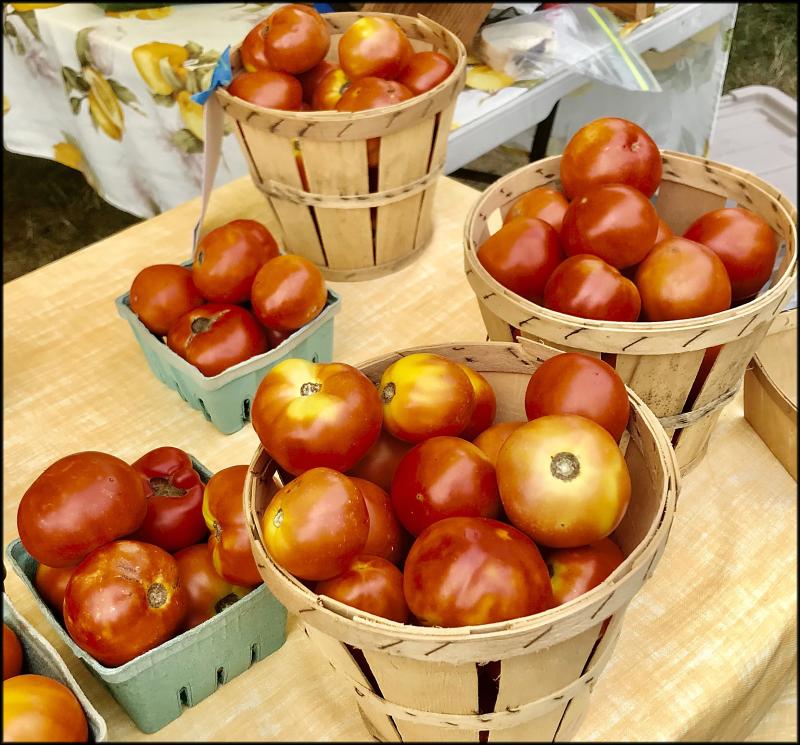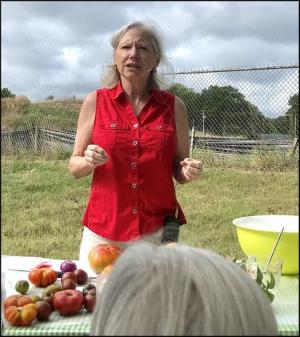August brings prime tomato time
Last weekend, the Historic Lewes Farmers Market held its annual Tomato Festival. Special events included guessing the number of tomatoes in a tall glass jar, voting on the largest tomato submitted to the contest and a cooking demonstration I was invited to conduct. Before I started to set up, I visited several growers to purchase ingredients, starting with fresh basil from Lavender Fields.
I selected a beautiful bunch of fragrant basil and mentioned that I was planning to use their lavender vinegar in my demo. Disappointed that she wouldn’t be able to have it available for sale that day, the vendor told me they were out until the plants bloomed again. It’s a delicious and delicate vinegar complete with a sprig or two of lavender in the bottle. Be sure to try it when it’s once again in stock.
My next stop was to find a red onion, which brought me to the tent of Herbs, Spice, Everything Nice, based in Selbyville. I saw all sorts of bright-red tomatoes (see photo) at booths across the grounds of the market, but found a large yellow one from Weathered Eye Farm in Lewes. I collected colorful green, almost-black and curiously shaped heirlooms from Stag Run Farm in Georgetown.
Based on the recipe I was planning to use, I needed some ripe peaches, which brought me to Bennett Orchards. They were offering both white and yellow varieties from their trees in Frankford, but Henry Bennett recommended I go with the yellow, which would better balance the acidity of the tomatoes in the salad and dressing I had in mind.
By the time we were ready to start the demo, almost every seat was filled. I’m not taking credit for all of the interest; remember, it was hot and the seats were under a tent. I began by sharing a little of the history of tomatoes and some of the lore associated with a food that is botanically a fruit, but legally a vegetable. Although their Latin name (lycopersicon) translates to “wolf peach” or poison in a pretty package, tomatoes are not poisonous.
Perhaps they gained this unpopular reputation during the 16th century when many dining utensils, bowls and plates were made of pewter. The highly acidic tomatoes would interact with the pewter alloy, leaching out the lead, which was not advisable to consume. Another reason might be their inclusion in the “nightshade” family of plants, some of which are toxic to humans.
Another curious characteristic ascribed to the tomato is its reputation as an aphrodisiac. The old Italian word for tomato was “pomme de Maure” or “apple of the Moors,” most likely because it was imported to Europe from the New World by the Spanish (sometimes referred to as the Moorish). This may also explain the romantic connection, as the similar-sounding French phrase is “pomme d’amour” or apple of love.
Now that you are familiar with all things tomato, you’re ready to figure out what to do with the bounty you collected from the market vendors. One thing to keep in mind is to never store them in the refrigerator, because cold kills their flavor-producing enzymes and ruins their texture. Don’t worry if your tomatoes are less than perfect. Save the slightly bruised ones for tomato sauce.
For the demo, we used a combination of large and small tomatoes to maximize the range of colors and flavors, cutting them into one-inch pieces. I asked Henry Bennett to help me cut the peaches, since he has perfected an efficient slice-and-dice technique. The basil added herbal notes, and crumbled feta cheese brought the right amount of saltiness to balance the simple olive oil and lavender vinaigrette. This salad is easy to prepare, and the mixture works perfectly. There were no leftovers.
Tomato & Peach Salad
1 1/2 lbs heirloom tomatoes
2 or 3 ripe peaches
1/4 C minced red onion
4 oz feta cheese
6 basil leaves
3 T lavender vinegar
3 T olive oil
Chop the tomatoes in one-inch pieces, making sure to collect their juices as you place them in a serving bowl. Cut the peaches in half, then twist the halves in opposite directions to reveal and remove the pit. Cut each half into one-inch crescents, then cut into pieces and add to the bowl. Loosely chop or crumble the feta; add to the bowl. Stack the basil leaves and roll up tightly; chop and add the tendrils to the bowl. Combine vinegar and oil in a measuring cup and whisk until emulsified. Pour over the salad and toss to combine. Yield: 6 to 8 servings.
Basic Tomato Sauce
10 lbs tomatoes*
1 T olive oil
1 diced onion
1 t dried basil
1/2 t marjoram
1/2 t thyme
1-inch heel of Parmesan cheese
Bring a large pot of water to a rolling boil. With a slotted spoon, add 5 tomatoes, one at a time. When the skin wrinkles and starts to loosen (about 10 seconds), remove tomatoes to a colander and rinse under cold water. Repeat with remaining tomatoes. Remove the skins by peeling them off with your fingers. Discard the skins and core the tomatoes. In a large saucepan, sauté the onion in olive oil until softened. Add the tomatoes along with the basil, marjoram, thyme and chunk of Parmesan. Simmer for at least 30 minutes or up to 2 hours, stirring regularly. Remove any remaining cheese. Purée the sauce in a food processor or with an immersion blender. Season to taste with salt and pepper. *Note: this is an ideal way to use tomatoes that are too imperfect to serve fresh.























































